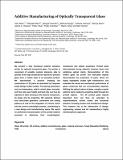Additive Manufacturing of Optically Transparent Glass
Author(s)
Klein, John; Stern, Michael; Franchin, Giorgia; Kayser, Markus Aurel Rasmus; Inamura, Chikara; Dave, Shreya H.; Weaver, James C.; Houk, Peter B.; Colombo, Paolo; Oxman, Neri; Yang, Maria C.; ... Show more Show less
DownloadOxman_Additive manufacturing.pdf (232.4Kb)
OPEN_ACCESS_POLICY
Open Access Policy
Creative Commons Attribution-Noncommercial-Share Alike
Terms of use
Metadata
Show full item recordAbstract
We present a fully functional material extrusion printer for optically transparent glass. The printer is composed of scalable modular elements able to operate at the high temperatures required to process glass from a molten state to an annealed product. We demonstrate a process enabling the construction of 3D parts as described by computer-aided design models. Processing parameters such as temperature, which control glass viscosity, and flow rate, layer height, and feed rate can thus be adjusted to tailor printing to the desired component, its shape, and its properties. We explored, defined, and hard-coded geometric constraints and coiling patterns as well as the integration of various colors into the current controllable process, contributing to a new design and manufacturing space. We report on performed characterization of the printed materials executed to determine their morphological, mechanical, and optical properties. Printed parts demonstrated strong adhesion between layers and satisfying optical clarity. This molten glass 3D printer demonstrates the production of parts that are highly repeatable, enable light transmission, and resemble the visual and mechanical performance of glass constructs that are conventionally obtained. Utilizing the optical nature of glass, complex caustic patterns were created by projecting light through the printed objects. The 3D-printed glass objects described here can thus be extended to implementations across scales and functional domains including product and architectural design. This research lies at the intersection of design, engineering, science, and art, representing a highly interdisciplinary approach.
Date issued
2015-04Department
Massachusetts Institute of Technology. Department of Materials Science and Engineering; Massachusetts Institute of Technology. Department of Mechanical Engineering; Massachusetts Institute of Technology. Media Laboratory; Program in Media Arts and Sciences (Massachusetts Institute of Technology)Journal
3D Printing and Additive Manufacturing
Publisher
Mary Ann Liebert, Inc.
Citation
Klein, John, Michael Stern, Giorgia Franchin, Markus Kayser, Chikara Inamura, Shreya Dave, James C. Weaver, Peter Houk, Paolo Colombo, Maria Yang, and Neri Oxman. "Additive Manufacturing of Optically Transparent Glass." 3D Printing and Additive Manufacturing. September 2015, 2(3): 92-105.
Version: Author's final manuscript
ISSN
2329-7662
2329-7670